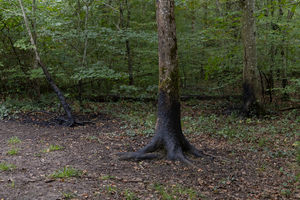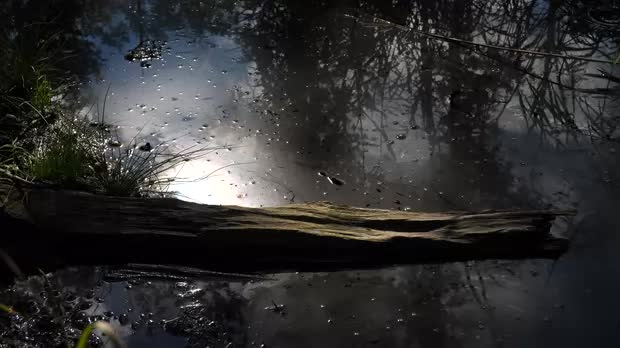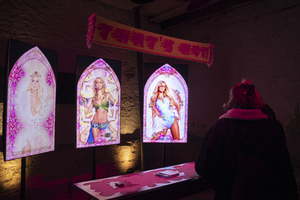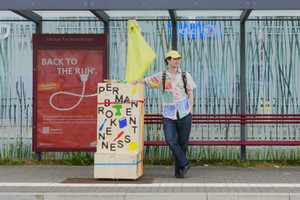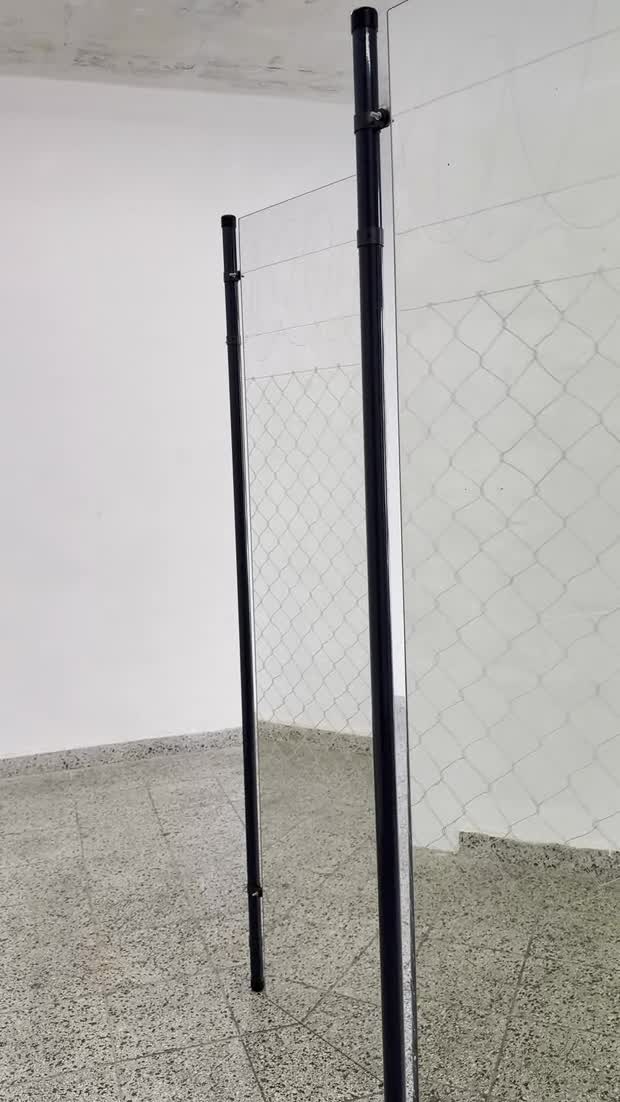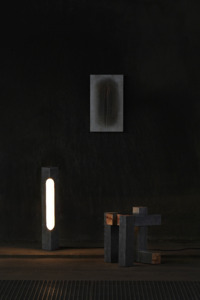Lukas Klein
| Name | Lukas Klein |
10 Inhalte
- Seite 1 von 1
Folded Sheets
- Titel
- Folded Sheets
- Autor/in
- Beschreibung (de)
- Folded Sheets untersucht, wie sich Papier-Falttechniken auf Stahlbleche übertragen lassen. Rechteckige Tafeln werden durch gezielte Einschnitte und Faltungen in stabile dreidimensionale Formen gebracht, ohne dass Material verloren geht. Der Prozess des Schwarzbrennens, bei dem Leinöl in die Oberfläche eingebrannt wird, verleiht den Objekten ihre charakteristische schwarze Färbung, schützt sie vor Korrosion und unterstützt die strukturelle Festigkeit.
- Beschreibung (en)
- Folded Sheets explores the possiblities of transferring paper folds into steel sheet furniture. By using cuts and folds on rectangular steel sheets, tensioned rigid shapes without offcuts are created. The objects are further strengthend by blackening the surface with burnt linseed oil.
- Kategorie
- Typ des Projekts/Werks
- Schlagworte
- Datierung
- 2025
- Dank an
- Material
- Technik/Verfahren/Formate
- Falttechnik, Schwarzbrennen mit Leinöl
- Stadt
- Land
- Internetlinks
- Titel
- Folded Sheets
- Projektleiter/in
- Studiengang
- Typ der Abschlussarbeit
- Importiert am
- 15.07.2025
- Übergeordnete Sets
- 2
- Set enthält
- 0 17
block to blob - publication
- Titel
- block to blob - publication
- Titel (en)
- block to blob - publication
- Autor/in
- Kategorie
- Titel
- block to blob - publication
- Projektleiter/in
- Studiengang
- Typ der Abschlussarbeit
- Importiert am
- 19.11.2024
- Übergeordnete Sets
- 1
- Set enthält
- 0 2
block to blob - objects
- Titel
- block to blob - objects
- Titel (en)
- block to blob - objects
- Autor/in
- Kategorie
- Titel
- block to blob - objects
- Projektleiter/in
- Studiengang
- Typ der Abschlussarbeit
- Importiert am
- 19.11.2024
- Übergeordnete Sets
- 1
- Set enthält
- 0 4
block to blob - exhibition
- Titel
- block to blob - exhibition
- Titel (en)
- block to blob - exhibition
- Autor/in
- Kategorie
- Titel
- block to blob - exhibition
- Projektleiter/in
- Studiengang
- Typ der Abschlussarbeit
- Importiert am
- 19.11.2024
- Übergeordnete Sets
- 1
- Set enthält
- 0 7
block to blob - videos
- Titel
- block to blob - videos
- Titel (en)
- block to blob - videos
- Autor/in
- Kategorie
- Typ des Projekts/Werks
- Titel
- block to blob - videos
- Projektleiter/in
- Studiengang
- Typ der Abschlussarbeit
- Importiert am
- 19.11.2024
- Übergeordnete Sets
- 1
- Set enthält
- 0 6
WHERE LEGENDS ARE MADE AND LIES ARE TOLD
- Titel
- WHERE LEGENDS ARE MADE AND LIES ARE TOLD
- Autor/in
- Beschreibung (de)
- WHERE LEGENDS ARE MADE AND LIES ARE TOLD (graduation project). Originated by this divine union of @parishilton @britneyspears @lindsaylohan (aka the Holy Trinity <3) the night of the infamous Bimbo Summit, WLAMALAT is the visual and critical translation of my obsession for the #y2k it-girls and #popculture in general. Mixing a religious with a highly commercial aesthetic, the project questions several topics such as women representation in the mass media, visual/celebrity culture consumption and new belief systems.
- WHERE LEGENDS ARE MADE AND LIES ARE TOLD (graduation project). Originated by this divine union of @parishilton @britneyspears @lindsaylohan (aka the Holy Trinity <3) the night of the infamous Bimbo Summit, WLAMALAT is the visual and critical translation of my obsession for the #y2k it-girls and #popculture in general. Mixing a religious with a highly commercial aesthetic, the project questions several topics such as women representation in the mass media, visual/celebrity culture consumption and new belief systems.
- Beschreibung (en)
- WHERE LEGENDS ARE MADE AND LIES ARE TOLD (graduation project). Originated by this divine union of @parishilton @britneyspears @lindsaylohan (aka the Holy Trinity <3) the night of the infamous Bimbo Summit, WLAMALAT is the visual and critical translation of my obsession for the #y2k it-girls and #popculture in general. Mixing a religious with a highly commercial aesthetic, the project questions several topics such as women representation in the mass media, visual/celebrity culture consumption and new belief systems.
- WHERE LEGENDS ARE MADE AND LIES ARE TOLD (graduation project). Originated by this divine union of @parishilton @britneyspears @lindsaylohan (aka the Holy Trinity <3) the night of the infamous Bimbo Summit, WLAMALAT is the visual and critical translation of my obsession for the #y2k it-girls and #popculture in general. Mixing a religious with a highly commercial aesthetic, the project questions several topics such as women representation in the mass media, visual/celebrity culture consumption and new belief systems.
- Kategorie
- Typ des Projekts/Werks
- Datierung
- 06.12.23
- Dank an
- Ort
- Rudolf 5
- Titel
- WHERE LEGENDS ARE MADE AND LIES ARE TOLD
- Projektleiter/in
- Semester
- Studiengang
- Typ der Abschlussarbeit
- Importiert am
- 05.11.2024
- Übergeordnete Sets
- 1
- Set enthält
- 3 8
block to blob
- Titel
- block to blob
- Titel (en)
- block to blob
- Untertitel
- tracing back materiality
- Untertitel des Projekts/Werks (en)
- tracing back materiality
- Autor/in
- Beschreibung (de)
- Dieses Diplomprojekt dokumentiert den Materialstrom von synthetischen Kunststoffen durch einen rückwärtsgerichteten chronologischen Ansatz. Es kombiniert Feldforschung, visuelle Dokumentation und Materialexperimente, um die Reise von Kunststoffen von ihren Endprodukten zurück zu ihrem Ursprung im Erdöl nachzuvollziehen.
"Block to Blob" umfasst Besuche an verschiedenen Orten der Produktionskette, wie etwa Produktionsanlagen, Ölraffinerien, Pipelines und Förderstätten und endet in einem Waldökosystem, wo Rohöl auf natürliche Weise an die Erdoberfläche tritt. Diese Erfahrungen werden in einer Forschungspublikation zusammengestellt, die dieser rückwärtsgerichteten Erzählweise folgt.
Eine Videoinstallation dokumentiert die besuchten Orte und liefert einen visuellen Kontext zu den industriellen Prozessen, der verborgenen Infrastruktur und der natürlichen Substanz im Wald. Zusätzlich verankert eine Reihe von Objekten, die aus mit Erdöl beschichtetem Holz und Polystyrol gefertigt sind, das Projekt in greifbaren Materialien.
- Dieses Diplomprojekt dokumentiert den Materialstrom von synthetischen Kunststoffen durch einen rückwärtsgerichteten chronologischen Ansatz. Es kombiniert Feldforschung, visuelle Dokumentation und Materialexperimente, um die Reise von Kunststoffen von ihren Endprodukten zurück zu ihrem Ursprung im Erdöl nachzuvollziehen.
- Beschreibung (en)
- This diploma project details the material stream of synthetic plastics through a reverse chronological approach. It combines field research, visual documentation, and material experimentation to retrace the journey of plastics from their final products back to their origins in petroleum.
‘block to blob’ includes visits to various sites in the production chain, such as manufacturing facilities, oil refineries, pipelines, and extraction sites, concluding in a forest ecosystem, where crude oil naturally seeps to the earth's surface. These experiences are compiled into a research publication that follows this reverse narrative.
A video installation documents the visited locations, providing visual context for the industrial processes, hidden infrastructure and the natural substance in the forest. Additionally, a series of objects made from petroleum-coated wood and polystyrene grounds the project in tangible materials.
- This diploma project details the material stream of synthetic plastics through a reverse chronological approach. It combines field research, visual documentation, and material experimentation to retrace the journey of plastics from their final products back to their origins in petroleum.
- Kategorie
- Typ des Projekts/Werks
- Schlagworte
- Datierung
- 2024
- Sprache
- Untertitel (Film)
- Material
- Technik/Verfahren/Formate
- Pine wood coated with petroleum, Wood soaked in gasoline and pressed/bonded with polystyrene
- Abmessungen
- L x B x H mm, Petroleum-coated wooden objects: Bench: 800 x 200 x 450, 2x T-Stool: 350 x 200 x 450, Stool (3-legged): 450 x 270 x 450, Stool (wide): 600 x 450 x 450, TV stand: - Polystyrene Objekts: Counter: 500 x 370 x 1100, 2x Bench1: 1000 x 570 x 400, Bench2: 1300 x 570 x 350, Stool: 500 x 370 x 570
- Dauer
- 1.: upstream 0 - oil seeping naturally to the surface - Alsace - 2:55min, 2.: upstream 1 - prospect drilling for oil reservoirs - Weingarten - 2:17min, 3.: upstream 2 - horse head pumps extracting oil - Landau - 3:50min, 4.: midstream - transalpine pipeline - Triest-Karlsruhe - 10:40min, 5.: downstream 1 - germany biggest oil refinery - Karlsruhe - 3:13min, 6.: downstream 2 - world biggest chemical plant - Ludwigshafen - 2:19min
- Ort: Institution
- Ort
- Lichthof 3
- Stadt
- Land
- Titel
- block to blob
- Projektleiter/in
- Semester
- Studiengang
- Typ der Abschlussarbeit
- Lehrveranstaltung
- Importiert am
- 03.11.2024
- Übergeordnete Sets
- 3
- Set enthält
- 4 1
PERMANENT BROKENNESS
- Titel
- PERMANENT BROKENNESS
- Autor/in
- Beschreibung (de)
- PERMANENT BROKENNESS ist eine mobile (Infra-)Struktur, die das transformative Potential von öffentlichen Orten aufzeigt, indem sie die Reparatur von Haushalts- und Konsumgeräten verfügbar und sichtbar macht. Angelehnt an das Format des Reparatur-Cafés, werden Benutzer*innen dazu eingeladen eigenständig und gemeinsam Dinge zu reparieren. Hierbei steht nicht nur die Müllvermeidung und Ressourcenschonung im Vordergrund, sondern vor allem der selbstwirksame Zugang zur dinglichen Umwelt. Das Projekt basiert auf einer umfangreichen Recherche zur kulturellen Praxis des Reparierens und formuliert ein Gegennarrativ zu Hegemonien der Produktion, der Innovation und des unreflektierten Massenkonsums.
- Beschreibung (en)
- PERMANENT BROKENNESS is a mobile (infra-)structure that demonstrates the transformative potential of public spaces by making the repair of household and consumer appliances available and visible. Inspired by the repair café format, users are invited to repair things independently and together. The focus here is not only on avoiding waste and conserving resources, but above all on self-effective access to the material environment. The project is based on extensive research into the cultural practice of repairing and formulates a counter-narrative to hegemonies of production, innovation and unreflected mass consumption.
- Kategorie
- Schlagworte
- Datierung
- 26.06.2024
- Mitwirkende
- Dank an
- Titel
- PERMANENT BROKENNESS
- Projektleiter/in
- Semester
- Studiengang
- Typ der Abschlussarbeit
- Importiert am
- 01.11.2024
- Übergeordnete Sets
- 1
- Set enthält
- 0 6
Afterfire Seminar
- Titel
- Afterfire Seminar
- Beschreibung (de)
- Mit einer Kombination aus praktischen, experimentellen und forschungsbasierten Ansätzen und einem Fokus auf Materialien untersuchten Studierende und Lehrende im Seminar Afterfire unsere Beziehung zum Feuer im Laufe der Geschichte und im Vergleich zu heute. Geleitet von den Gastprofessoren Paco Boekelmann und Kevin Rouff von Studio Thusthat fand das Seminar im Wintersemester 2022/23 an der HfG Karlsruhe statt.
In einer Zeit von Kriegen, knappen Energieressourcen und der Klimakrise konzentrierte sich das Afterfire Seminar auf unsere besondere Übergangszeit, in der wir uns (theoretisch) von fossilen Brennstoffen entfernen und nach neuen Feuerquellen suchen. In Vorträgen, Gastvorträgen, Ortsbesichtigungen, Workshops und Einzelarbeiten untersuchten Studierende und Lehrende die Nutzung von Feuer und verschiedenen Brennstoffen im Laufe der Jahrhunderte und konzentrierten sich dabei auf das, was nach dem Feuer übrig bleibt - die Asche.
Nach einem Besuch des Kohlekraftwerks im Karlsruher Rheinhafen organisierte Studio Thusthat einen Workshop, um den Vorläufer der Steinkohle zu erforschen: die Holzkohle. Die Studierenden schufen Werkstücke, hauptsächlich aus Holz, und bauten einen Ofen, in dem alle Objekte am letzten Tag des Workshops ohne Sauerstoff gebrannt wurden, so dass sie zu Holzkohle wurden.
Der zweite Workshop konzentrierte sich auf die drei "neuen" wichtigsten alternativen Brennstoffsektoren: den Bereich der holzigen Biomasse, den Bereich der landwirtschaftlichen Nebenprodukte und den Bereich der Energiegewinnung aus Abfällen. Zwei Tage lang analysierten die Studierenden in Gruppenarbeit die repräsentativen Brennstoffe Holz, Stroh und Siedlungsabfälle im Hinblick auf die vielen Nuancen, die für und gegen ihre Nutzung als Energiequelle sprechen.
Neben und in Verbindung mit den Workshops wurden im Laufe des Semesters individuelle studentische Projekte entwickelt, die auf den Recherchen von Studio Thusthat aufbauten und eigene Prozesse, Phänomene, Effekte oder Zusammenhänge von Feuer theoretisch und praktisch erarbeiteten.
Am Ende des Semesters wurden alle studentischen Projekte in einer Ausstellung im Lichthof der HfG Karlsruhe präsentiert, wo die Projekte der Öffentlichkeit präsentiert wurden. Eine Auswahl der Projekte, an denen die Studierenden über das Seminar hinaus weitergearbeitet haben, wurde beim Rundgang und bei der Karlsruher Museumsnacht 2023 ausgestellt.
- Mit einer Kombination aus praktischen, experimentellen und forschungsbasierten Ansätzen und einem Fokus auf Materialien untersuchten Studierende und Lehrende im Seminar Afterfire unsere Beziehung zum Feuer im Laufe der Geschichte und im Vergleich zu heute. Geleitet von den Gastprofessoren Paco Boekelmann und Kevin Rouff von Studio Thusthat fand das Seminar im Wintersemester 2022/23 an der HfG Karlsruhe statt.
- Beschreibung (en)
- With a combination of practical, experimental and research-based approaches and a focus on materials, students and teachers in the Afterfire seminar examined our relationship to fire throughout history and in comparison to today. Led by guest professors Paco Boekelmann and Kevin Rouff from Studio Thusthat, the seminar took place in the winter semester 2022/23 at the HfG Karlsruhe.
In a time of wars, scarce energy resources and climate crisis, the Afterfire Seminar focused on our particular transitional period in which we are (theoretically) moving away from fossil fuels and looking for new sources of fire. Through lectures, guest talks, site visits, workshops and individual work, students and teachers explored the use of fire and different fuels over the centuries, focussing on what remains after the fire - the ash.
Following a visit to the coal-fired power station in Karlsruhe's Rheinhafen, Studio Thusthat organised a workshop to explore the precursor to hard coal: charcoal. The students created workpieces, mainly out of wood, and built a kiln in which all the objects were burnt without oxygen on the last day of the workshop, turning them into charcoal.
The second workshop focussed on the three "new" main alternative fuel sectors: the woody biomass sector, the agricultural by-products sector and the waste-to-energy sector. For two days, students worked in groups to analyse the representative fuels wood, straw and municipal waste with regard to the many nuances that speak both for and against their use as an energy source.
Alongside and in conjunction with the workshops, individual student projects were developed throughout the semester, which built on Studio Thusthat's research and worked out their own processes, phenomena, effects or connections of fire in theory and practice.
At the end of the semester, all student projects were presented in an exhibition in the Lichthof of the HfG Karlsruhe, where the projects were explained and shown to the public. A selection of the projects on which students continued to work beyond the seminar was exhibited during the Rundgang and at the Karlsruhe Museumsnacht 2023.
- With a combination of practical, experimental and research-based approaches and a focus on materials, students and teachers in the Afterfire seminar examined our relationship to fire throughout history and in comparison to today. Led by guest professors Paco Boekelmann and Kevin Rouff from Studio Thusthat, the seminar took place in the winter semester 2022/23 at the HfG Karlsruhe.
- Kategorie
- Typ des Projekts/Werks
- Mitwirkende
- Sprache
- Titel
- Afterfire Seminar
- Importiert am
- 10.06.2024
- Übergeordnete Sets
- 1
- Set enthält
- 4 0
FLAME SPRAYED
- Titel
- FLAME SPRAYED
- Autor/in
- Beschreibung (de)
- FLAME SPRAYED
Metall und Holz sind einander nicht fremd. Eisennägel halten seit Jahrhunderten Holzstücke zusammen. Aber was passiert, wenn diese uralte Verbindung aus einer mechanischen zu einer alchemistischen Einheit wird? Die Antwort liegt nicht in der mittelalterlichen Zauberei, sondern in einem industriellen Hightech-Verfahren. Das Metallflammspritzen geht auf Beobachtungen zurück, als Munition mit den Objekten verschmolz, auf die sie abgefeuert wurde, und hat sich zu einer Technik entwickelt, die in spezialisierten Werkstätten vor allem für den Korrosionsschutz von Metallen eingesetzt wird. Bei der Arbeit mit einem Metallsprüher fielen mir die Holzabschnitte auf, die als Träger für die besprühten Objekte verwendet wurden, sie wirkten wie metallisiert.
Der Spiegel, die Lampe und der Hocker der Serie FLAME SPRAYED reflektieren die hybriden Eigenschaften des Materials: Eine spiegelartig polierte Holzmaserung, ein in Stücke geschnittener Balken mit offenen Enden und eine leitfähige Holzoberfläche, die als Schalter fungiert.
- FLAME SPRAYED
- Beschreibung (en)
- FLAME SPRAYED
Metal and wood are no strangers to each other. Iron nails have been holding pieces of wood together for centuries. But what happens when this age-old bond gets transforms from a mechanical to an alchemical unison? The answer doesn't come from medieval wizardry but from a high-tech industrial process. Metal Flame Spraying dates back to observations, when ammunition fused with the objects it was fired at, developed into a technique that sits tucked away in specialised workshops primarily used for metal corrosion protection. Working with a metal-sprayer, I noticed the sacrificial wood offcuts being used as supports for the sprayed objects, and was caught by their unexpected appeal when seemingly metallified.
The mirror, lamp and stool of the series FLAME SPRAYED reflect the hybrid properties of the material: A mirror-like polished wood grain, a beam cut into pieces with open ends and a conductive wooden surface that acts as a switch.
- FLAME SPRAYED
- Kategorie
- Typ des Projekts/Werks
- Schlagworte
- Datierung
- 2023/24
- Material
- Abmessungen
- Mirror 57 x 33 x 3 cm, Stool (open ends) 49 x 40 x 40 cm, Lamp 100 x 12 x 12 cm
- Ort
- ?
- Stadt
- Land
- Bemerkungen
- Mein Projekt FLAME SPRAYED hat im Afterfire Seminar WS22/23 begonnen (Januar 2023 Projekt start) und ist danach zu einem freien Projekt geworden, an dem ich jetzt noch arbeite.
- Titel
- FLAME SPRAYED
- Projektleiter/in
- Studiengang
- Importiert am
- 07.06.2024
- Übergeordnete Sets
- 1
- Set enthält
- 0 6

